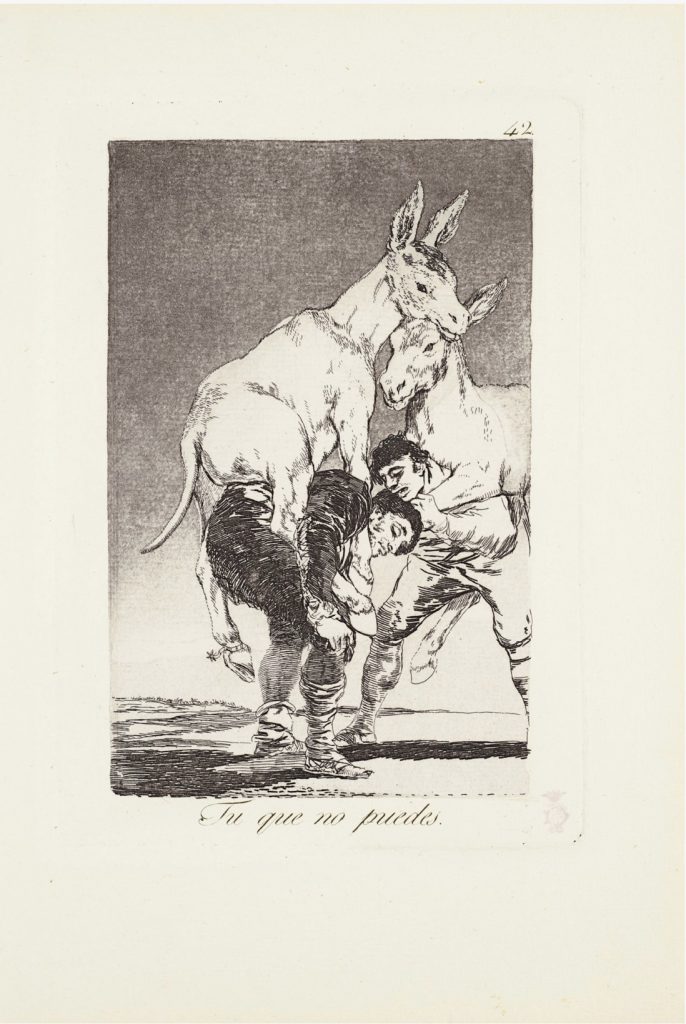
You who canst not (Tu que no puedes)
Plate 42 from: Los Caprichos
etching with burnished aquatint, drypoint and engraving, on laid paper, a good impression from the First Edition, published by the artist, Madrid, 1799, framed
Plate: 83⁄8 x 6 in. (213 x 152 mm.)
Sheet: 113⁄4 x 8 in. (298 x 203 mm.)
Shallow then Halo will host 21 prints, selected pieces from three different series: Los caprichos (1797),The disasters of war (1810), and Los Disparates (1815). Los Caprichos are a set of 80 prints in aquatint and etching created between 1797-1798, published as an album in 1799. The prints were an artistic experiment: a medium for Goya’s condemnation of the universal follies and foolishness in the Spanish society in which he lived. The criticisms are far-ranging and acidic; the images expose the predominance of superstition, the ignorance and inabilities of the various members of the ruling class, pedagogical short-comings, marital mistakes and the decline of rationality. Some of the prints have anticlerical themes. Goya described the series as depicting “the innumerable foibles and follies to be found in any civilized society, and from the common prejudices and deceitful practices which custom, ignorance or self-interest have made usual”.
‘The disasters of war’ is a title given later on to the series by art historians, Goyas handwritten title on an album of proofs given to a friend reads: Fatal consequences of Spain’s bloody war with Bonaparte, and other emphatic caprices (Spanish: Fatales consequencias de la sangrienta guerra en España con Buonaparte, Y otros caprichos enfáticos).Aside from the titles or captions given to each print, these are Goya’s only known words on the series, but it is believed to be a visual protest against the violence of the 1808 Dos de Mayo Uprising, the subsequent Peninsular War of 1808–1814 and the setbacks to the liberal cause following the restoration of the Bourbon monarchy in 1814.
With these works, Goya breaks from a number of painterly traditions: He rejects the bombastic heroics of most previous Spanish war art to show the effect of conflict on individuals. In addition, he abandons colour in favour of a more direct truth he found in shadow and shade.
The last series, ‘Los disparates’, also known as Proverbios (Proverbs) or Sueños (Dreams), is a series of prints in etching and aquatint, with retouching in drypoint and engraving. Created between 1815 and 1823, the series is impossible to categorize thematically. The best way to describe its scenes is, in fact, as the materialization of dreams and proverbs drawn from Spanish culture,dark, dream-like scenes that scholars have related also to the Spanish carnival.
The works by goya in their totality will mark the rithm of the whole exhibition, guiding the viewer across the path of works by the different authors, anchoring the underlying tread within it all. Like a virglius throught the circles, Goya, the master, accompany us in a forest of shallow, then halo.
Francisco José de Goya y Lucientes (30 March 1746 – 16 April 1828) was a Spanish painter and printmaker. He is considered the most important Spanish artist of the late 18th and early 19th centuries, often referred to as the last of the Old Masters and the first of the moderns.
His paintings, drawings, and engravings reflected contemporary historical upheavals of his time and influenced painters from all over the world, and still do to this day.
-Text by Sara van Bussel
